MIS10E testbank CH02 PDF

| Title | MIS10E testbank CH02 |
|---|---|
| Author | Mohammed Salim |
| Course | Corporate Financial Management |
| Institution | Al Akhawayn University |
| Pages | 21 |
| File Size | 257.4 KB |
| File Type | |
| Total Downloads | 50 |
| Total Views | 159 |
Summary
Download MIS10E testbank CH02 PDF
Description
Chapter 2
Global E-Business: How Businesses Use Information Systems True-False Questions 1.
Operational management is responsible for directing the day-to-day operations of the business and therefore needs transaction-level information. Answer: True
2.
Difficulty: Medium
Reference: p. 52–53
Difficulty: Easy
Reference: p. 52
Difficulty: Medium
Reference: p. 52
Management information systems typically support nonroutine decision making. Answer: False
8.
Reference: p. 46
A hotel reservation system is a typical example of a management information system. Answer: False
7.
Difficulty: Medium
A transaction processing system is a computerized system that performs and records the daily routine transactions necessary to conduct business. Answer: True
6.
Reference: p. 57
Transaction processing systems are most commonly used by the senior management level of an organization. Answer: False
5.
Difficulty: Easy
Operational-level manufacturing systems deal with the firm’s long-term manufacturing goals, such as where to locate a new plant. Answer: False
4.
Reference: p. 52
Deciding whether to introduce a new product line is the responsibility of an operational manager. Answer: False
3.
Difficulty: Easy
Difficulty: Medium
Reference: p. 53–54
The decision to grant credit to a customer is normally made by the middle manager. Answer: False
Difficulty: Medium
17
Reference: p. 52
9.
Transaction processing systems are the basic business systems that serve the operational level of the organization. Answer: True
10.
Reference: p. 54
Difficulty: Medium
Reference: p. 57
Difficulty: Medium
Reference: p. 57
Difficulty: Medium
Reference: pp. 57–58
Difficulty: Medium
Reference: p. 61
Enterprise systems often include transactions with customers and vendors. Answer: True
19.
Difficulty: Medium
Information supplied by an enterprise system is structured around cross-functional business processes. Answer: True
18.
Reference: p. 54
ESSs are designed primarily to solve specific problems. Answer: False
17.
Difficulty: Easy
ESSs are designed to incorporate data about external events, but they also draw summarized information from internal MIS and DSS. Answer: True
16.
Reference: p. 53–54
ESSs are designed to serve the middle management of the organization. Answer: False
15.
Difficulty: Medium
Decision-support systems use internal information as well as information from external sources. Answer: True
14.
Reference: p. 52
Decision-support systems help managers make decisions that are unique, rapidly changing, and not easily specified in advance. Answer: True
13.
Difficulty: Medium
Most MISs use sophisticated mathematical models or statistical techniques. Answer: False
12.
Reference: p. 52
Managers need TPSs to monitor the status of internal operations and the firm’s relations with the external environment. Answer: True
11.
Difficulty: Medium
Difficulty: Easy
Reference: p. 61
Supply chain management systems are more externally oriented than enterprise systems. Answer: True
Difficulty: Hard
18
Reference: pp. 61–63
20.
Maintaining online directories of employees with special areas of expertise is one application of knowledge management systems. Answer: True
Difficulty: Medium
Reference: p. 65
Multiple-Choice Questions 21.
(Analysis) Kia’s difficulties in getting a complete picture of defects in their cars illustrates: a. b. c. d.
the difficulties in creating accurate tracking systems. the challenges posed by having multiple information systems that are not linked. the difficulties in complying with government regulations. the compromises made in drawing accurate reports from poorly planned information systems.
Answer: b
Difficulty: Easy
Reference: p. 48
(Analysis in terms of differentiating) 22.
(Analysis, Synthesis) How would you best categorize the types of systems Kia implemented in their defect early warning system? a. b. c. d.
A TPS to store basic data about vehicles, parts, sales, and warranties, and an MIS to create reports on the data A TPS to store basic data about vehicles, parts, sales, and warranties, and a DSS for high-level analysis and forecasts An MIS to create reports from existing TPSs and a DSS for high-level analysis and forecasts A production and manufacturing system to record basic data about faulty parts and a DSS for high-level analysis and forecasts
Answer: c 23.
Difficulty: Hard
Reference: pp. 48–49
Which of the following is a cross-functional business process? a. b. c. d.
Hiring an employee Identifying a customer Fulfilling a customer order Creating an invoice
Answer: c
Difficulty: Easy
19
Reference: pp. 42–43
24.
Promoting the organization’s products or services is a responsibility of the: a. b. c. d.
finance and accounting function. human resources function. manufacturing and production function. sales and marketing function.
Answer: d 25.
finance and accounting function. human resources function. manufacturing and production function. sales and marketing function.
Answer: d
Reference: p. 45
a sales and marketing information system serving senior management. a sales and marketing information system serving middle management. a finance and accounting information system serving senior management. a finance and accounting information system serving middle management.
Answer: b
Difficulty: Medium
Reference: p. 45
A sales and marketing information system aids operational management in: a. b. c. d.
tracking sales. planning new products and services. analyzing sales performance. preparing sales forecasts.
Answer: a 28.
Difficulty: Easy
Pricing analysis is an example of: a. b. c. d.
27.
Reference: p. 45
Market research is an activity associated with the: a. b. c. d.
26.
Difficulty: Easy
Difficulty: Medium
Reference: p. 45
A sales and marketing information system aids middle management employees in: a. b. c. d.
tracking sales. planning new products and services. analyzing sales performance. preparing sales forecasts.
Answer: c
Difficulty: Medium
20
Reference: p. 45
29.
Equipment scheduling and facilities maintenance are functions of: a. b. c. d.
finance and accounting systems. human resources systems. manufacturing and production systems. sales and marketing systems.
Answer: c 30.
plan long-term profits. decide where to locate new facilities. forecast sales trends. control the firms’ financial resources.
Answer: a
Reference: p. 50
operational management. sales and marketing. senior management. middle management.
Answer: d
Difficulty: Medium
Reference: p. 50
A finance and accounting information system aids operational management with: a. b. c. d.
establishing long term investment goals. profit planning. accounts receivable. budgeting.
Answer: c 33.
Difficulty: Medium
Budgeting is typically a feature of an information system serving: a. b. c. d.
32.
Reference: p. 45
Senior management uses finance and accounting information systems to: a. b. c. d.
31.
Difficulty: Easy
Difficulty: Medium
Reference: p. 50
Compensation analysis is an example of: a. b. c. d.
finance and accounting information systems. enterprise application information systems. human resources information systems. sales and marketing information systems.
Answer: c
Difficulty: Easy
21
Reference: p. 51
34.
The total elapsed time, from the beginning of a business process to the end of the process, is called: a. b. c. d.
completion time. requisition-to-pay. fulfillment. cycle time.
Answer: d 35.
knowledge management systems. transaction processing systems. executive-support systems. management information systems.
Answer: d
Reference: p. 53–54
integrated data processing throughout the firm. transaction process reporting. employees with online access to historical records. middle management functions.
Answer: d
Difficulty: Easy
Reference: p. 53
To monitor the status of internal operations and the firm’s relations with the external environment, managers need _________ systems a. b. c. d.
decision-support knowledge transaction processing management information
Answer: c 38.
Difficulty: Hard
The term “management information systems” designates a specific category of information systems serving: a. b. c. d.
37.
Reference: p. 61
A relocation control system that reports summaries on the total moving, house-hunting, and home financing costs for employees in all company divisions would fall into the category of: a. b. c. d.
36.
Difficulty: Hard
Difficulty: Medium
Reference: p. 52
As discussed in the chapter case on Tupperware, what major change precipitated Tupperware’s need to implement a new information systems strategy? a. b. c. d.
Move into overseas operations Merger Business model change Change in suppliers
Answer: c
Difficulty: Medium
22
Reference: p. 39
39.
These systems are typically a major source of data for other systems: a. b. c. d.
transaction processing systems. management information systems. executive support systems. decision-support systems.
Answer: a 40.
management. transaction processing. executive support. decision-support.
Answer: d
Reference: p. 54
management information systems. transaction processing systems. decision-support systems. knowledge management systems.
Answer: c
Difficulty: Medium
Reference: p. 54
Executive support systems are information systems that support the: a. b. c. d.
long-range planning activities of senior management. knowledge and data workers in an organization. decision-making and administrative activities of middle managers. day-to-day processes of production.
Answer: a 43.
Difficulty: Easy
These systems are especially suited to situations in which the procedure for arriving at a solution may not be fully predefined in advance: a. b. c. d.
42.
Reference: p. 52
Decisions that are unique, rapidly changing, and not easily specified in advance are best suited to this type of system: a. b. c. d.
41.
Difficulty: Medium
Difficulty: Easy
Reference: p. 57
(Synthesis) BioSense, the application developed by the CDC to report on disease trends, would be best classified as a(n): a. b. c. d.
management information system. transaction processing system. decision-support system. executive-support system.
Answer: a
Difficulty: Hard
23
Reference: p. 77
44.
(Synthesis) Many hospitals are described in the BioSense case study as being reluctant to implement BioSense. The organizational challenges that dissuade some hospitals from using the BioSense program include: a. b. c. d.
the incompatibility of the hospital’s information systems to the BioSense system. the costs of standardizing information. concerns regarding responsibility for managing a pandemic. all of the above.
Answer: c
Difficulty: Hard
Reference: p. 78
(Synthesis in terms of bringing knowledge together) 45.
(Synthesis) Concur Expense Service software, described in the Interactive Session: Management as software that automates the travel and entertainment expense-reporting process, would be classified as a(n): a. b. c. d.
ESS. DSS. finance and accounting system. human resources system.
Answer: d
Difficulty: Medium
Reference: p. 55
(Synthesis in terms of bringing knowledge together) 46.
Decision-support systems are often referred to as: a. b. c. d.
business information systems. business intelligence systems. business analysis systems. business modeling systems.
Answer: b 47.
Difficulty: Medium
Reference: p. 57
ESS are specifically designed to serve this level of the organization: a. b. c. d.
operational. end-user. middle management. senior management.
Answer: d
Difficulty: Easy
24
Reference: p. 57
48.
These systems often deliver information to senior executives through a portal, which uses a Web interface to present integrated personalized business content: a. b. c. d.
transaction processing systems. executive support systems. management information systems. decision-support systems.
Answer: b 49.
Decision-support systems Management information systems CRM Enterprise applications
Answer: d
Reference: p. 59
transaction system enterprise system automatic reporting system management information system
Answer: b
Difficulty: Medium
Reference: p. 61
___________________________ is the process that integrates supplier, manufacturer, distributor, and customer logistics processes. a. b. c. d.
Collaborative distribution Supply-chain management Reverse logistics Enterprise planning
Answer: b 52.
Difficulty: Easy
A(n) _______________________ collects data from various key business processes and stores the data in a single, comprehensive data repository, usable by other parts of the business. a. b. c. d.
51.
Reference: p. 58
These systems are designed to support organization-wide process coordination and integration. a. b. c. d.
50.
Difficulty: Medium
Difficulty: Medium
Reference: p. 62
_______________________ uses a set of integrated applications to address all aspects of the customer relationship. a. b. c. d.
CRM MIS CLE CLU
Answer: a
Difficulty: Easy
25
Reference: p. 64
53.
(Analysis) Which type of system would you use to determine what trends in your supplier’s industry will affect your firm the most in five years? a. b. c. d.
ESS TPS MIS DSS
Answer: a
Difficulty: Easy
Reference: p. 57
(Analysis in terms of differentiate and appraise) 54.
(Analysis) Which type of system would you use to forecast the return on investment if you used new suppliers with better delivery track records? a. b. c. d.
ESS TPS MIS DSS
Answer: d
Difficulty: Medium
Reference: pp. 54–56
(Analysis in terms of differentiate and appraise) 55.
(Analysis) Which type of system would you use to change a production schedule if a key supplier was late in delivering goods? a. b. c. d.
ESS TPS MIS DSS
Answer: b
Difficulty: Medium
(Analysis in terms of differentiate and appraise)
26
Reference: pp. 52–53
56.
(Analysis) Which type of system would you use to determine the five suppliers with the worst record in delivering goods on time? a. b. c. d.
ESS TPS MIS DSS
Answer: c
Difficulty: Medium
Reference: pp. 53–54
(Analysis in terms of differentiate and appraise) 57.
Which types of systems consolidate the relevant knowledge and experience in the firm to make it available to improve business processes and management decision making? a. b. c. d.
TPS Extranets KMS CRM
Answer: c 58.
Difficulty: Medium
Reference: pp. 65–66
(Synthesis) What type of information system is an intranet most easily adapted to: a. b. c. d.
CRM. MIS. TPS. KMS.
Answer: d
Difficulty: Hard
Reference: pp. 65–66
(Synthesize in terms of bringing information together) 59.
Buying or selling goods over the Internet is called: a. b. c. d.
e-commerce. e-business. an intranet. an extranet.
Answer: a
Difficulty: Easy
27
Reference: p. 67
60.
The use of digital technology and the Internet to execute the major business processes in the enterprise is called: a. b. c. d.
e-commerce. e-business. enterprise applications. MIS.
Answer: b 61.
programmer. information systems manager. systems analyst. CTO.
Answer: c
Reference: p. 68
CEO CFO CIO CTO
Answer: c
Difficulty: Easy
Reference: p. 68
The advantage of a having a centralized information services department, which operates as a separate department similar to other departments is: a. b. c. d.
that this is more likely to produce more compatible systems and more coherent longterm systems development plans. that this lowers costs of technology purchases. that systems are built that directly address that function’s business needs. that systems are built that can function independently and more efficiently.
Answer: a 64.
Difficulty: Easy
A __________ is a senior manager who oversees the use of IT in the firm. a. b. c. d.
63.
Reference: p. 67
The principal liaison between the information systems groups and the rest of the organization is a(n): a. b. c. d.
62.
Difficulty: Easy
Difficulty: Hard
Reference: p. 70
(Evaluate) What is the most important benefit of an enterprise application? a. b. c. d.
Enabling speed of communicating Enabling business functions and departments to share information Enabling a company to work collaboratively with customers and suppliers Enabling cost-effective, e-business processes
Answer: b
Difficulty: Hard
28
Reference: p. 59
Similar Free PDFs

MIS10E-testbank-CH02
- 21 Pages

MIS10E testbank CH02
- 21 Pages

MIS10E testbank CH04
- 20 Pages

MIS10E testbank CH03
- 20 Pages

MIS10E testbank CH15
- 19 Pages

MIS10E testbank CH11
- 19 Pages

MIS10E testbank CH10
- 16 Pages
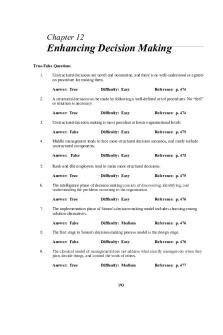
MIS10E testbank CH12
- 18 Pages
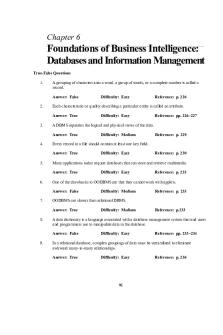
MIS10E testbank CH06
- 18 Pages

Ch02 Testbank - Test Bank, Chapter 2
- 76 Pages
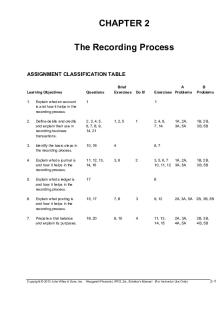
Ch02
- 66 Pages
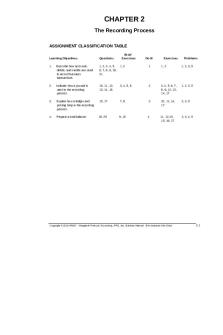
Ch02
- 60 Pages
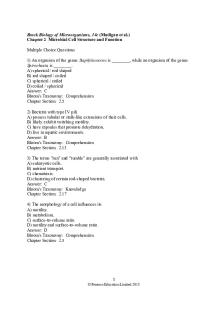
Ch02
- 18 Pages

Ch02 PPT
- 71 Pages

Ch02 Analyzing Transactions
- 64 Pages

HW Week2 Solution ch02
- 6 Pages
Popular Institutions
- Tinajero National High School - Annex
- Politeknik Caltex Riau
- Yokohama City University
- SGT University
- University of Al-Qadisiyah
- Divine Word College of Vigan
- Techniek College Rotterdam
- Universidade de Santiago
- Universiti Teknologi MARA Cawangan Johor Kampus Pasir Gudang
- Poltekkes Kemenkes Yogyakarta
- Baguio City National High School
- Colegio san marcos
- preparatoria uno
- Centro de Bachillerato Tecnológico Industrial y de Servicios No. 107
- Dalian Maritime University
- Quang Trung Secondary School
- Colegio Tecnológico en Informática
- Corporación Regional de Educación Superior
- Grupo CEDVA
- Dar Al Uloom University
- Centro de Estudios Preuniversitarios de la Universidad Nacional de Ingeniería
- 上智大学
- Aakash International School, Nuna Majara
- San Felipe Neri Catholic School
- Kang Chiao International School - New Taipei City
- Misamis Occidental National High School
- Institución Educativa Escuela Normal Juan Ladrilleros
- Kolehiyo ng Pantukan
- Batanes State College
- Instituto Continental
- Sekolah Menengah Kejuruan Kesehatan Kaltara (Tarakan)
- Colegio de La Inmaculada Concepcion - Cebu